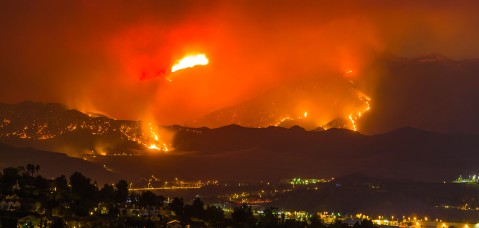October 2017’s wildfires in Northern California, burning hundreds of thousands of acres and forcing thousands from their homes, have proved to be only the beginning of a hugely destructive wildfire period for the Golden State. At the time of writing, Southern California is still bearing the brunt from a number of fires around the Los Angeles area and Ventura County where the so-called Thomas Fire ‒ currently the third largest in Californian wild fire history ‒ has so far covered over 260,000 acres, destroying or damaging over 900 homes, threatening 18,000 homes, and displacing over 95,000 residents.
The wildfire risk in California is not new but since records began in the 1930s, California has never before seen major wildfires in December. As the population density grows however and the number of potential ignition sources increases, together with the changing climate ‒ the current wildfires are happening in California’s rainy season which has been unseasonably dry ‒ the problem is only likely to get worse. A trend recently noted by California’s Governor Gerry Brown who, according to the, LA Times, called the fire damage in Ventura County "the new normal," adding: "This could be something that happens every year or every few years."
Who carries the can?
Even as the fires rage, thoughts have inevitably turned to the cause of the fires and where liability should lie. With some estimates for the October fires alone putting losses at over US$10 billion, it could result in some long and protracted legal battles.
Fingers have begun to point at utility providers including Pacific Gas & Electric (PG&E) for the fires in Northern California and Southern California Edison for the most recent fires. Generally in the US, utility companies operate on a strict liability basis which means if their cabling for example is found to have sparked and caused a fire, or even if a car driver hits one of their pylons, they will be on the hook for all the subsequent losses.
The state doesn’t allow the utility companies to pass any costs on to consumers either so, if found liable, those companies (carrying large insurance retentions) and their insurers will be looking to subrogate their losses wherever possible. Companies who could feel the brunt of subrogation efforts include telecomms companies - who often use power companies’ infrastructure to carry their own cabling ‒ as well as others such as vegetation management companies working for utilities and municipalities.
Pool losses
The London Market picks up a fair slug of general liability insurance business for many of these companies so many of the losses will work through London at some point which might kick off further discussions as to how viable the insurance product becomes. While no one is suggesting London is about to pull out of the class, something will probably have to change in the way utilities buy insurance cover if the wildfire trends carry on as they are. A government backed industry insurance pool might be one solution.
In the meantime, as fire fighters continue to douse the flames around Southern California, we wait to see what the final human and financial cost will be.



